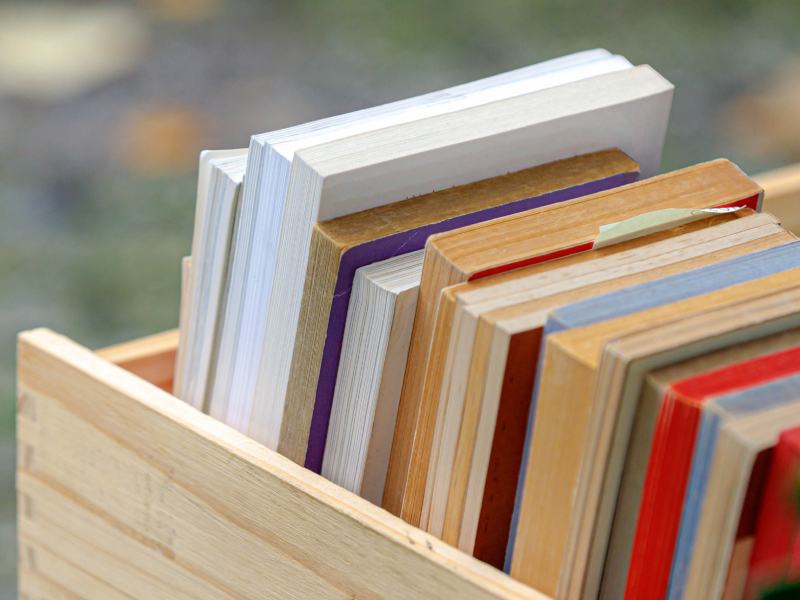How to Store Books on Display & Long Term: 6 Easy Tips!
-
Pete Ortiz
- Last updated:

A book lover’s worst nightmare is to pull out their favorite read only to find it warped, bent, faded, or damaged by mold. Books are quintessential in thrusting you into a world of imagination, and it’s perfectly normal to want to cling to the work of your favorite authors.
So, how should you store your books? And how do you turn your book storage areas into your favorite place in the house?
If you have piles of books you never want to part with, the last thing you should do is shove them in a dusty corner in your garage. Dive in for great tips to help you avoid rookie mistakes that could get your treasured reads damaged. We will also share insight on using stored books to add texture, color, and an element of interest to your spaces.
The 6 Tips on How to Store Books
1. Display Books on Bookshelves

Bookshelves are your best bet if you love having your favorite books right where you can see them. While storing books on a bookshelf seems like a no-brainer, you must implement some not-so-obvious tips to ensure your prized readable possessions remain in pristine condition.
Start by finding the right spot for the bookshelf. Make sure the location allows proper air circulation without subjecting your books to excessive temperature fluctuations.
Generally, you should pick an area away from direct sunlight because UV rays can cause the covers and pages to fade. The correct location for your bookshelf should have a temperature no higher than 70 degrees Fahrenheit. This will reduce the risk of mold growth and ensure your books don’t bend or crack. Also, keep the books snuggled well but not too tightly to allow proper ventilation.
You can turn your bookshelves into an exciting focal point depending on the available space. Consider buying or building DIY bookshelves that match your interior design theme. Some of the best designs include sculpture shelves, cube shelves, floating shelves, hanging racks, and vintage bookshelf styles.
2. Use Plastic Bins
If you have more books than you can neatly arrange on your bookshelves, consider storing the rest in plastic bins. Opaque plastic containers are the best because they protect books from harmful UV rays. Ensure the bins have tight lids to keep off insects and rodents.
Ensure you choose small tubs instead of larger ones that can be harder to carry when filled with books. Depending on the number of tubs you fill, you can stack them up for a neat and visually appealing arrangement.
It may not be a good idea to store your plastic bins in the attic, basement, or garage. These areas are prone to drastic temperature fluctuations and humidity changes. It is necessary to find a location where the temperatures are consistently cool.
An excellent spot to consider is under your bed or couch. These locations also allow easy access to your favorite reads. You can also set several boxes at the foot of your bed and cover them with fabric to keep off dust and make them more visually appealing.
3. Use Sturdy Cardboard Boxes

You can still store books in your garage, attic, or basement. Using sturdy cardboard boxes instead of plastic bins makes more sense here as they reduce the chances of mold by allowing better air circulation.
You can add an extra layer of security by using an AC or dehumidifier for climate control. Also, wrap the books in fabric for added protection and seal the box to keep them dust free. Ensure the cardboard boxes are not directly on the floor because they can absorb moisture from your flooring.
Don’t just tuck away your beloved books and forget about them. Open a box or two periodically to ensure they are in pristine condition.
4. Use Your Halls and Corridors as Storage Spots
Do you have a mudroom or a hall tree bench at your entrance?
That small area where you leave your coats, shoes, and keys makes an ideal storage space for your beloved books. It can also make your book collection the focal point of your entryways and not necessarily your dirty boots.
Put books in plastic bins and slide them underneath your entryway bench. If your hall tree has shelves or storage cubbies, arrange your books in neat stacks and blend them with other eye-catching accessories.
Use the same trick on other halls and corridors to store extra books. Get creative with your entryway organization ideas to reduce the risk of your spaces looking cluttered with books.
5. Use Stacked Crates or Wooden Pellets

Plastic crates and wooden pellets have a unique visual appeal. If you have old milk crates and small-sized pellets from reclaimed wood, you can stack them with your books inside. Build an unconventional DIY book storage unit by stacking the plastic or wooden crates on the side.
Better still, you can separate your books by order of genre and place them in different spots in your home. For instance, your cookbooks can end up in a space adjacent to your kitchen, while crates with children’s books can be mounted on a wall in their room.
6. Arrange Them in Unconventional Spots
We all differ in our preferences on how to store books. Sometimes, the ideal way to keep your precious reads safe will depend on the number of books you have and the available space.
If you lack space or the budget to install bookshelves and don’t like using plastic bins, wooden pellets, or sturdy cardboard, all is not lost. You can use what you have.
Do you have a dull console you hardly use? Style it up with your favorite reads. You can arrange your books according to their author, genre, color, size, etc. The idea is to turn your console into a focal point and still make it dead simple to find the book you are looking for. You can also add matching or color-clashing accessories on the console to give it an interesting vibe.
Other unconventional areas to store your books include but are not limited to the following.
- On stools close to seating areas
- In your bathroom cabinets or shelves
- By the side of your bed, next to your reading lamp
- Right above the headboard
FAQs
What Is the Best Way to Store Rare Books?
Rare book editions are expensive and hard to find. You are likely attached to them emotionally or monetarily. Putting them in plastic bins and storing them in your basement, attic, or garage is, unfortunately, not the best way to keep them away from curious eyes or damaging hands. It’s better to frame them on the wall or invest in a dedicated bookshelf for your rare reads.

What Is the Best Humidity for Storing Books?
Most books remain pristine when the relative humidity is below 50%. However, the ideal relative humidity for books is around 35%. This will ensure your favorite reads don’t grow mold, warp, or curl. To be safe, ascertain that your garage, attic, or basement has climate control and good dry air circulation.
How Do I Store Books if I Have a Small Apartment?
If you have limited space in your apartment, it is necessary to get creative when finding suitable spots to store your books. Consider installing floating shelves to use the vertical spaces in your home. If the room is still insufficient, consider renting a climate-controlled storage unit. Remember to check on your books regularly to ensure they are pristine.
Takeout Tips for Storing Books:
- Always retain the dust jackets of stored books
- Arrange stored books by size, color, or genre for easy retrieving
- Regularly dust your stored books and their storage rooms & units
- Routinely wipe down stored books with a lint-free cloth
- Maintain relatively low humidity in rooms with books
- Keep books off areas with direct heat or sunlight
- Store the books flat or upright, not with the spine or binding pointing upward
- Ensure your hands are clean and dry before handling stored books
Final Thoughts
If the world of books makes your soul happy, you cannot underestimate the need to store your favorite reads correctly. Whether you find it comforting to see your books displayed or would rather tack them away, we hope our storage tips come in handy.
There’s no harm in renting a storage unit if you have lots of books and minimal space in your home. Ensure the unit has temperature control, and don’t forget to be a good librarian. It is necessary to check the stored books regularly and dust them properly.
Featured Image Credit: jarmoluk, Pixabay
Contents


